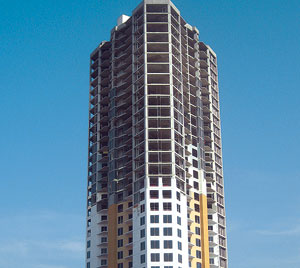The “implosion” of the faulty, 31-story condominium tower and interconnected four-level parking garage on South Padre Island in Texas is not going to be standard by any measure, says the demolition contractor. The razing by explosives is complicated by the failed structural elements—a consequence of differential settlement between the structural concrete tower and the post-tensioned garage; post-tensioned beams; the tower’s robust frame; the high water table; and sand that conducts vibrations to nearby buildings, says J. Mark Loizeaux, president of Controlled Demolition Inc.
Phoenix, Md.,-based CDI expects to raze the topped-out, half-clad building at the end of November or in early December. “We’re not going to rush it. We have a lot to learn before we finalize the plan,” says Loizeaux.
CDI is currently weighing four demolition plans, each with different nuances. After test blasting, CDI will decide whether to hinge the tower structure at the fourth floor, above the post-tensioning, to take it out of play, or hinge the building at the pile-cap level. If the hinge is above the garage structure, there is a reverse-thrust sheer component to take into account. “The tower wants to kick back,” says Loizeaux.
The 381-ft-tall tower, designed by Datum Engineers Inc., Austin, has a two-way, flat-plate slab with 4,000 psi concrete and top and bottom reinforcing. Columns have 5,000 psi concrete at and above level 18 and 6,000 psi below. Mechanical splices were used on lower-wall reinforcing to avoid congestion from lap splices. The core measures 22 ft x 31 ft in plan, with 2.5-ft-thick walls at the base, decreasing to 2 ft in the tower. Two stair towers each are 12 ft x 24 ft in plan, with the same wall thicknesses as core walls.
The tower is on the west end of the garage, which is 200 ft x 237 ft in plan and has 24-in.-dia. concrete columns in 27 ft-wide bays. The foundation consists of 16-in.-dia augered, pressure-grouted piles, 95 ft long. Of 800-plus piles, 401 are under the tower’s concrete mat.
CDI’s biggest challenge is the garage’s post-tensioned, unbonded-tendon beams, which run through the tower base. “There is post-tensioning of over 2,000 kips in some,” says Loizeaux.
To avoid compromising the dunes, CDI intends to tilt the tower 15 degrees to the east toward the Gulf of Mexico and then have it start collapsing vertically. For either demolition approach, CDI expects to predemolish a 200-ft-wide by 150-ft-long garage section beyond the tower footprint to the east. “We don’t want the tower to drop on the garage because post-tensioning anchors can fly if you release the tendons too quickly,” says Loizeaux.
Another CDI challenge is drilling the 15⁄8-in.-dia. holes for the explosives in the core walls. The walls have four or five layers of heavy reinforcing steel and mechanical splices, which makes things more difficult, says Loizeaux. CDI expects to have to drill 25,000 to 30,000 holes to get the 3,000 it needs. “We were trying to drill 10 holes to get one, when the norm is drilling one and a half to get one,” he says. “We came in with hydraulic hammers and made no headway, so we are going to start preblasting because we can’t hammer,” he adds.
With the building topped out, half clad and partially fit out in the lower floors, Ocean Tower LP, the developer, stopped active construction in May 2008, except for remedial shoring, after differential settlement had reached more than 14 in. and there were cracks in columns, beams and pile caps. In November 2008, general contractor Coast Constructors Southwest Ventures, a division of Zachry Construction Corp., left the site. In June, Ocean Tower decided to demolish the building because “it is not economically feasible to complete” it and “provide the caliber of condominium tower” intended, says the developer.
In litigation, Ocean Tower claims the settlement is a result of “flawed engineering design.” In a petition filed on June 26, 2008, in the Cameron County district court, Ocean Tower alleges the geotechnical consultant, Raba-Kistner Engineering and Consulting Inc., San Antonio, and Datum are responsible for at least 14 in. to 16 in. of differential settlement beneath the tower core, 8 in. to 14. in. beneath the tower perimeter, 4 in. to 8 in. beneath the west parking garage and 1 in. to 2 in. beneath the east garage.
The different settlement “stressed the beams and columns” and resulted in “cracking, spalling and breaking of the beams and columns,” says the petition. According to a source, the structure looks as if it went through a seismic event.
Ocean Tower claims the problem was caused by failure to take into account a substratum of expandable and compressible clay, 120 ft to 190 ft down. “As a result of Raba’s miscalculation of the piers necessary to support the building (Raba authorized 95 ft piers after testing only down 100 ft), the building weight was focused on the clay stratum, which compressed, and allowed the building to settle,” says the claim. The petition says Datum “allowed for no settling of the structure” and engineered the tower to be “statically attached to the four-floor parking garage.”
The defendants decline to discuss details of the case, in which Ocean Tower seeks $125 million in damages. “Our client stands by the subsurface investigation it performed [and] believes it has factual and legal defenses to the allegations,” says Matthew Cano, Raba’s lawyer with Allensworth & Porter, Austin.
Greg Ziegler, Datum’s lawyer with MacDonald Devin PC, Dallas, says, “Datum disputes a substantial amount of the allegations in the petition” and “disputes any allegations that Datum is at fault.”










Post a comment to this article
Report Abusive Comment